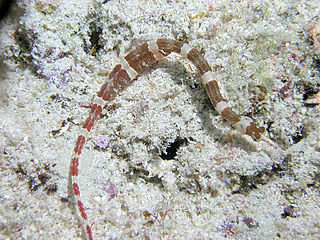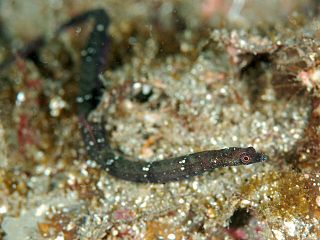
Corythoichthys intestinalis, known commonly as the scribbled pipefish, is a species of marine fish in the family Syngnathidae. Other common names used include banded pipefish, Australian banded pipefish, Australian messmate pipefish and messmate pipefish.

Corythoichthys amplexus, known commonly as the brown-banded pipefish, is a species of marine fish in the family Syngnathidae.
Cosmocampus albirostris is a marine fish of the family Syngnathidae. It is found in the western Atlantic Ocean, along the US coast from North Carolina to Florida, in the Gulf of Mexico, along the Yucatán Peninsula to Cuba, in the Caribbean from Puerto Rico to Grenada, and along Central and South America to southern Brazil. It lives among coral reefs, sea floor rubble, and sparse algae to depths of about 40 metres (130 ft), where it can grow to lengths of 20 centimetres (7.9 in). This species is ovoviviparous, with males carrying eggs in a brood pouch and giving birth to live young The Cosmocampus albirostris is a species of pipefish that has been historically collected in the State of Bahia. These species are in the Brazilian list of marine fishes that are authorized to be exported for ornamental purposes. This information was taken from a case study that monitored the ornamental trade of seahorses and pipefishes in Brazil, where harvesting of pipefish is common, and it was also discovered that Cosmocampus albirostris are predominantly harvested in reef areas.

Bulbanaricus davaoensis is a marine fish of the family Syngnathidae. It is found in the western Indian Ocean, the western Pacific Ocean from the Philippines to Fiji, and from Japan to the Great Barrier Reef, in Australia. Planktonic juveniles are found in the upper 200m of 610-7120m deep waters. The adult stage of this species is found among coral reefs to depths of 8m, and can grow to lengths of 4.3 cm. It is ovoviviparous, with the males carrying eggs in brood pouches until they are ready to hatch. It is a small secretive species which prefers to live among the galaxy coral Galaxea fascicularis.
Cosmocampus arctus is a species of marine fish of the family Syngnathidae. It is found from Tomales Bay, California, to Mazatlan, Mexico, and throughout the Gulf of California. It lives on rocky or coral reefs, among eelgrass and other seaweeds, and among algae. It inhabits depths to 10m, where it can grow to lengths of 12 cm. This species is ovoviviparous, with males carrying eggs in a brood pouch before giving birth to live young. Monogamous mating has also been observed in this species.
Cosmocampus banneri is a species of marine fish of the family Syngnathidae. It is found from the Red Sea and Western Indian Ocean to Fiji, the Marshall Islands, and the Ryukyu Islands. It lives in coral reefs at depths of 2-30m, where it can grow to lengths of 5.8 cm. Although little is known about the feeding habits of C. banneri, it is expected to feed on small crustaceans similar to other pipefish. This species is ovoviviparous, with males carrying eggs in a brood pouch until giving birth to live young. The specific name honours Albert Henry Banner (1914-1985), an American carcinologist who was an expert in alpheid shrimps.
Cosmocampus darrosanus is a species of marine fish of the family Syngnathidae. It is found in the Western Indian Ocean, Sri Lanka, Indonesia, Guam, and the Great Barrier Reef (Australia). It lives in tidepools and coral reefs to depths of 3 metres (9.8 ft), where it can grow to lengths of 7.4 centimetres (2.9 in). This species is ovoviviparous, with males carrying eggs before giving birth to live young. The specific name is taken from the type locality of D'Arros Island in the Amirante Islands.
Cosmocampus elucens is a species of marine fish of the family Syngnathidae. It is found in the western Atlantic, off the U.S. east coast, Bermuda, the Bahamas, the Gulf of Mexico, throughout the Caribbean Sea, and off the coast of Brazil. It lives in seagrass and algae beds, typically at shallow depths, where it can grow to lengths of 15 centimetres (5.9 in). It is expected to feed on small crustaceans, similar to other pipefishes. This species is ovoviviparous, with males carrying eggs and giving birth to live young.
Cosmocampus heraldi is a species of marine fish of the family Syngnathidae. It is known from only seven specimens, which were found at the Desventuradas and Juan Fernandez Islands in Chile. It inhabits rocky reefs and sandy areas at depths of 6–23 metres (20–75 ft), where it can grow to lengths of 7 centimetres (2.8 in). It is expected to feed on small crustaceans like other pipefish. This species is ovoviviparous, with males carrying eggs until giving birth to live young. The specific name honours the ichthyologist Earl Stannard Herald (1914-1973) who had a lifelong interest in pipefish.
Cosmocampus hildebrandi is a species of marine fish of the family Syngnathidae. It is found in the western Atlantic Ocean, off of the US coast from North Carolina south to the Gulf of Mexico, off the Yucatan Peninsula (Mexico), and off of northwestern Cuba. It inhabits sandy habitats with seagrass, coral, and rock substrates at depths of 5–75 metres (16–246 ft), where it can grow to lengths of 8.6 centimetres (3.4 in). This species is ovoviviparous, with males carrying eggs and giving birth to live young. The specific name honours the ichthyologist Samuel F. Hildebrand (1883-1949), who first recognised the holotype as being possibly a new species.
Cosmocampus howensis is a species of marine fish of the family Syngnathidae. It is found in the South Pacific from Jervis Bay to Easter Island. It lives in lagoons and on rocky reefs, where it grows to lengths of 10–12 centimetres (3.9–4.7 in). It is expected to feed on small crustaceans, similar to other pipefishes. This species is ovoviviparous, with males carrying eggs before giving birth to live young.
Cosmocampus investigatoris is a species of marine fish of the family Syngnathidae. It is found in the Indo-West Pacific, from the Persian Gulf to the Gulf of Thailand. It lives over sand, mud, and coral bottoms to depths of 15m, where it can grow to lengths of 9 cm. This species is ovoviviparous, with males carrying eggs in a brood pouch until giving birth to live young.
Cosmocampus profundus is a species of marine fish of the family Syngnathidae. It is found near the southeastern US, the Virgin Islands, and the Yucatan Peninsula of Mexico. The few specimens of this species that have been collected were found over sand and coral at depths of 100-265m. This species is ovoviviparous, with males carrying eggs before giving birth to live young.
Cosmocampus retropinnis is a species of marine fish of the family Syngnathidae. The name retropinnis comes from the location of the species' dorsal fin as either caudal or posterior. The coloration of this organism is mostly brown and tan markings on its snout side, head’s dorsum, side of the trunk, and venter of the tail. It is only known from a few juvenile specimens collected off southern Morocco and Gambia at depths to 79m. Little is known about its feeding habits, but it is expected to feed on small crustaceans, similar to other pipefish. This species is ovoviviparous, with males carrying eggs before giving birth to live young.

Doryrhamphus negrosensis, commonly known as Negros pipefish, flagtail pipefish, Masthead Island pipefish or Queensland flagtail pipefish, is a species of marine fish of the family Syngnathidae. It is found in the Western Pacific Ocean, from Borneo to Vanuatu and the Yaeyama Islands to the Rowley Shoals and the Great Barrier Reef. It lives in mud flats and reefs, both coral and rocky, where it is often associated with sea urchins. It is a rather solitary species which may be found in pairs or small groups. It inhabits depths to 9 metres (30 ft), and can grow to lengths of 6.2 centimetres (2.4 in). Although little is known of its feeding habits, it is expected to feed on harpacticoid copepods, gammarid shrimps, and mysids, similar to other pipefish, it may also act as a cleaner fish like other species in the genus Doryrhamphus. This species is ovoviviparous, with males carrying eggs before giving birth to live young. Males may brood at 4.3 cm. It is a small bluish to bluish-grey pipefish which has a pale stripe along the dorsal side of the head and snout, and a dark fan-like caudal fin which has white margins and an orange base.

Booth’s pipefish is a species of marine fish of the family Syngnathidae. It is found in the Western Indian Ocean, in South Africa and the Comoro Islands, and in the Western Pacific, from South Korea and Japan to the Great Barrier Reef and Tonga. It lives in rocks and coral reefs to depths of 30 metres (98 ft), where it can grow to lengths of 17.5 centimetres (6.9 in). This species is ovoviviparous, with males carrying eggs and giving birth to live young. The specific name honours for Julie Booth, who "presented many interesting fishes to the Australian Museum from New South Wales and Lord Howe Island".

Halicampus brocki, the tasselled pipefish, or Brock’s pipefish, is a species of marine fish of the family Syngnathidae. It is found in the Indo-Pacific, from southern Japan, Guam and the Marshall Islands to the central east and west coasts of Australia. It lives on coral and rocky reefs with algae, to depths of 45 metres (148 ft). It can grow to lengths of 12 centimetres (4.7 in), and is expected to feed on small crustaceans, similar to other pipefish. This species is ovoviviparous, with males carrying eggs and giving birth to live young. The specific name honours Vernon E.Brock who was the Director of the Fish and Game Department in Honolulu..

The Samoan pipefish, or brown pipefish, is a species of marine fish of the family Syngnathidae. It is found in the Indo-Pacific, from the Red Sea, to Sodwana Bay, to Taiwan, the Marshall Islands, and Samoa, where it inhabits tidepools and coral and rocky reefs to depths of 15 metres (49 ft). It is a solitary species with cryptic habits and is rarely observed. It is likely to feed on small crustaceans, and can grow to lengths of 14 centimetres (5.5 in). This species is ovoviviparous, with males carrying the fertilised eggs in a brood pouch, the folds of which fall well short of the centre of the egg-filled pouch, eventually giving birth to live young. The specific name honours Mataafa, a former king of Samoa. It is a listed marine species under the Australian Environment Protection and Biodiversity Conservation Act 1999.
The glittering pipefish is a species of marine coastal fish of the family Syngnathidae. It is found in the Western Pacific, from Viet Nam to Fiji and from the Ryukyu Islands to New Caledonia, where it inhabits corals, sand and reef flats to depths of 20 metres (66 ft).< It can grow to lengths of 7.3 centimetres (2.9 in), and is expected to feed on small crustaceans, similar to other pipefishes. It is secretive and rarely observed. This species is ovoviviparous, with males carrying eggs and giving birth to live young.
The spinysnout pipefish is a species of marine pipefish of the family Syngnathidae. It is found in the Indo-Pacific, from Sri Lanka to Samoa, and from Japan and the Marshall Islands to central Australia. It lives in rocky and coral reefs, rubble, lagoons and intertidal zones, often at depths of 2–12 metres (6.6–39.4 ft), where it can grow to lengths of 12 centimetres (4.7 in). It is expected to feed on small crustaceans, similar to other pipefish. This species is ovoviviparous, with males carrying eggs in a brood pouch before giving birth to live young.











